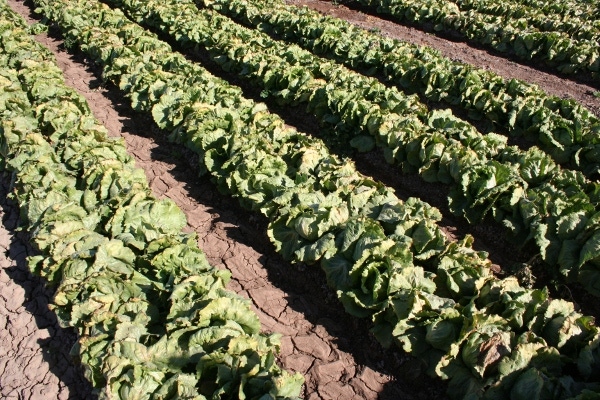
NOAA predicts for the second winter in a row that a moderate to strong La Niña will be the dominant climate factor influencing weather in Arizona and California this winter.The three ingredients required for plant disease development include a susceptible host, a pathogen capable of infecting the host, and a favorable environment.The three pest types most often cited as the source of most problems are insects, diseases, and weeds.
December 5, 2011

The latest Arizona Vegetable Integrated Pest Management Update from the University of Arizona (UA) Cooperative Extension in Yuma, Ariz., released Dec. 1, 2011.
Winter weather and insects in desert vegetables
By John Palumbo, UA Research Scientist and Extension Specialist
The National Oceanic and Atmospheric Administration’s (NOAA) Climate Prediction Center predicts for the second winter in a row that a moderate to strong La Niña will be the dominant climate factor influencing weather in Arizona and California this winter.
This suggests our local weather should be warmer and drier than average from December through February.
What impact will this have on insect pests normally found on leafy vegetables and melons this winter? It is not certain since predicting insect abundance is like predicting the weather.
The University of Arizona (UA) has collected data over the years which suggests that aphid pressure on lettuce is historically lighter during growing seasons when rainfall amounts are low (less than one-quarter inch). Similarly, seed corn maggot infestations are generally less severe under warm and dry growing conditions during the winter.
In contrast, western flower thrips abundance is historically higher under warm and dry weather conditions. From January through March 2010, we received over four inches of rain in the Yuma Valley. Thrips numbers were very low in UA research trials and seed corn maggots were quite damaging in a number of crops that spring.
If relying on the La Niña predictions, one might assume that aphid and seed corn maggot pressure will be lighter, and thrips numbers much heavier this winter and spring. Keep in mind - there are a number of other abiotic and biotic factors that also influence insect abundance.
To be on the safe side, "When in doubt, scout."
Contact Palumbo: (928) 782-3836 or [email protected].
Environment impact on disease development
Environment impact on disease development
By Mike Matheron, UA Extension Plant Pathologist
The three ingredients required for the development of most plant diseases include a susceptible host, a pathogen capable of infecting the host, and a favorable environment.
Two components of environment, temperature, and moisture are critical factors affecting the development and severity of diseases caused by bacterial and fungal pathogens.
A plant disease caused by these types of pathogens will not occur if the temperature and/or moisture levels prohibit the pathogen from interacting with the host to cause disease. This explains why some diseases only appear on a crop during particular times during the growing season.
For example, Fusarium wilt on lettuce in the desert is found primarily during the fall but not during the winter months, as soil temperatures in the fall but not the winter months favor the growth of the pathogen and disease development.
Downy mildew on winter vegetables including lettuce, cruciferous crops, onions, and spinach is usually a concern in the winter and early spring but only when periods of leaf wetness caused by rainfall and dew are present. Periods of high humidity and leaf wetness are essential for the downy mildew pathogens to grow, proliferate, and cause disease.
The generally dry conditions prevalent in the desert benefit growers by restricting foliar diseases caused by bacteria and many fungi. The same organisms can flourish in regions receiving abundant rainfall.
Growers cannot control the weather. However, they do have control over irrigation practices which in some cases can influence the severity of vegetable crop diseases.
For example, the severity of Sclerotinia drop on lettuce can be increased by over irrigation, especially if this results in the prolonged wetting of the bed top. Also, during periods of rainfall and high humidity, sprinkler irrigation can extend the duration of high foliar moisture and increase the severity of downy mildew.
Contact Matheron: (928) 726-6856 or [email protected].
Impact of weeds compared to insects, diseases
Impact of weeds compared to insects, diseases
By Barry Tickes, UA Area Agriculture Agent
There are many different types of pests that affect crops grown in Arizona. The three types of pests most often cited as the source of most problems are insects, diseases, and weeds.
These are the same types of pests that are cited as causing the major agricultural pest problems across the U.S. and worldwide.
The relative importance of these types of pest problems differ in Arizona from the rest of the U.S. and worldwide.
In terms of pesticide use, worldwide herbicides account for 36 percent of total usage, insecticides 25 percent, fungicides 10 percent, and other products (nematicides, rodenticides, etc.) at 29 percent.
In the U.S., herbicides accounted for 44 percent, insecticides 10 percent, fungicides 6 percent, and others products at 40 percent.
In Arizona, however, insecticides account for 58 percent, herbicides 17 percent, and fungicides 12 percent.
This is only an indirect measure of the relative importance of these three areas of pest management and may be heavily influenced by the amount of pesticides used.
For example, it is common to spray for insects five or more times per season while it is uncommon to spray for weeds more than twice. Nonetheless, weeds are the predominant pest problem in agricultural areas across the U.S. and worldwide.
Contact Tickes: (928) 580-9902 or [email protected].
You May Also Like



